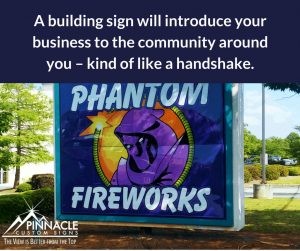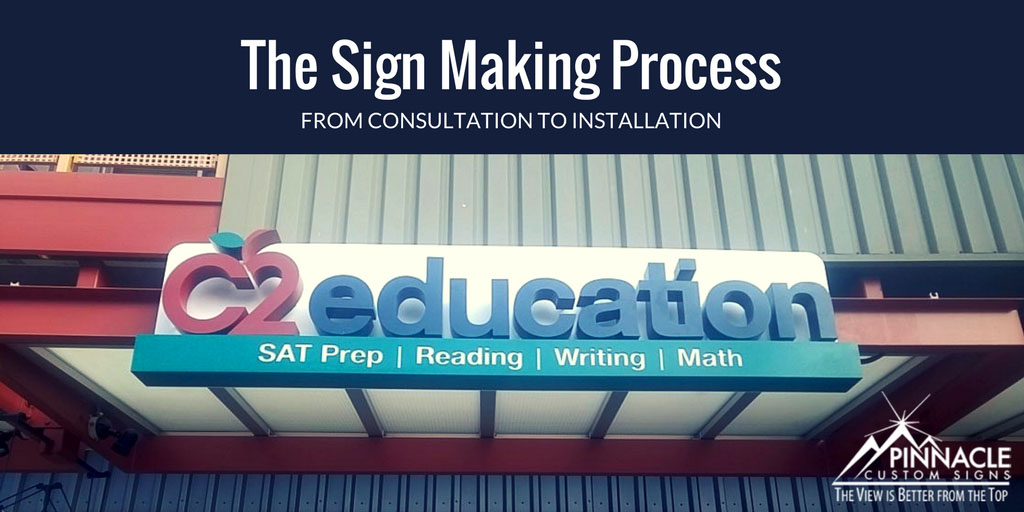Today we are going to talk about the sign making process, from consultation to installation. While most of the steps in the process are the same for every type of sign, we’ll discuss the steps for getting a building sign.
 But first, let’s talk about WHY building signs are important. A building sign will introduce your business to the community around you – kind of like a handshake. It lets both potential and existing customers know who you are and maybe a little bit about what you do.
But first, let’s talk about WHY building signs are important. A building sign will introduce your business to the community around you – kind of like a handshake. It lets both potential and existing customers know who you are and maybe a little bit about what you do.
Therefore, signage is important to bringing customers to your front door. Recently, one of our customers, C2 Education, told us that 15-20% of their new customers are a direct result of their building signs.
Now that we’ve told you why a building sign is important to your business, let’s go through the process to get your building sign in place.
Building signs come in all sizes, shapes, and types. Some are lighted, while others are not – some are dimensional while others are flat. No matter what type you are looking for, we start the process with an initial consultation.
Consultation & Site Survey
Once we receive the initial request from our customer, we will typically set up a time to meet with him/her to get an understanding of what they are looking for and what they hope to accomplish with the sign. We will try to determine if the sign is to be lighted or not, the types of materials they had in mind, the colors as well as if there are any restrictions/limitations being imposed by the landlord.
During this consultation, we will also take several pictures of the building as well as measurements that will allow us to create the initial design. Common measurements include the length of the front of the building and the dimensions of the windows and doors, just to name a few. Some of these measurements will be needed for reference – to help us scale the sign to the correct dimensions and others may come into play during the permitting process.
Designing the Sign
After the site survey is completed, all the information that was gathered is used to create a work order that the designer will use to create the design. The designer will also need to consider a few other factors, most of which are centered on the permitting process when they create the first draft of their design. We don’t want to create a design that we know will not be approved by the municipality that governs the business’ jurisdiction. So, we have to determine which measurements are key in regulating the maximum allowable size before we begin the design process.
Other factors that are important to the design process are things such as:
- Whether or not the logo will be used in the sign and whether the customer has a version in a vector format which will allow us to scale the logo large enough for the sign without distorting it. If this isn’t available, we will need to re-create it in order to make the sign.
- Another consideration that goes into the design is whether there are any specific brand standards, such as specific colors or spacing requirements that need to be followed. This often comes into play for businesses that are part of a franchise or have set those standards in place to maintain brand consistency.
- Finally, the types of materials that will be used for the sign from a cost, appearance and longevity standpoint will also be a part of the design. A building sign will typically be used for quite a while, so you don’t want to use materials to build the sign that are not long-lasting.
The result of the design is a proof that is sent to the customer for approval. Often, revisions will be made until the design is approved by the customer. Once approved, we can then provide a more accurate estimate for both the time needed as well as the cost, depending on the manufacturing process we will use.
For almost all electrical building signs, such as lighted cabinets and channel letter signs, we send the design to our manufacturer to get his cost estimate and when they can put it into production. We will also determine who will perform the installation in order to estimate these costs as well. After the customer approves the final estimate, we typically require a 50% deposit to get work going and we then begin working on sign permits.
Sign Permitting
Here the customer has the option to apply for the permit themselves or have us do it for a nominal fee. If they choose to do it themselves, we provide them with the appropriate information, including scaled diagrams to complete and submit the application. But, if the customer prefers to have us submit the application, we have them complete a form that gives us the information such as the building owner, business license number, building measurements, etc. required by the city, county or municipality. Generally, municipalities can take up to 30 days to approve a sign permit application if there are no problems. However, if there are any issues with the application, it can take a bit longer than this.
Manufacturing & Production
Once the permit is approved, the sign then goes into manufacturing & production. We don’t do this prior to the permit being approved in case there are issues that will cause us to re-design the sign in order to get it approved.
Most “in house” production will take a week or two, depending on the volume of work we have scheduled as well as the number of internal processes (like routing, printing, cutting) needed to fabricate the sign.
However, if we are not producing the sign, we place the order with an external vendor who has their own production schedule. For example, our lighted sign manufacturer will typically take 2-3 weeks to produce a standard channel letter sign, 3-5 weeks for a lighted cabinet sign or 4-6 weeks for a backlit or “halo” sign, depending on the size or other specifications.
Sign Installation
After production and fabrication are completed, we then schedule the installation with the customer. The time needed for installation depends on the type of sign, the size and the location of the building. Another factor in determining the installation is whether the electricity for a lighted sign is available and readily accessible. If not, then an electrician may need to be called in to complete the job, as our installers are not certified electricians.
Upon completion of the job, the site is cleaned up, completion pictures are taken and the job is done. At this time final payment for the sign is due. Often, we finish up by showing off the job on all our social media sites, giving our customer a little bit of advertising for their business.
Pinnacle Custom Signs Is Your One-Stop Sign Shop
We know how important business signs are to your business. They represent your brand and your image to your customers. From building signs to trade show displays and more, Pinnacle Custom Signs provides you the expertise to create striking custom signs to bring attention to your business.
If you are looking for a new building sign to get your business noticed, give us a call or fill out the form on the right to begin the process we just walked through.
View the related Slidedeck here: The Sign Making Process
View the related video on Youtube here.







